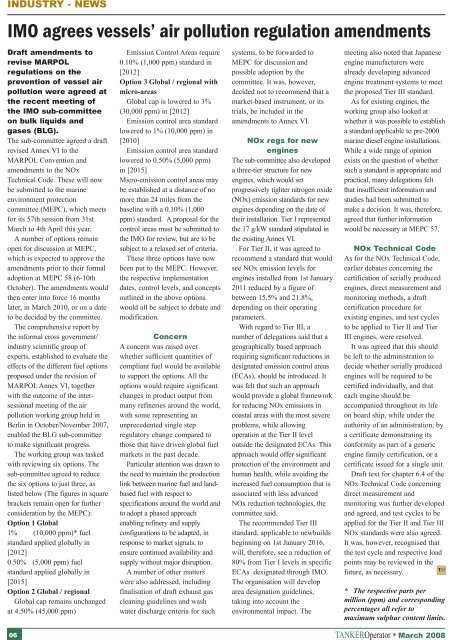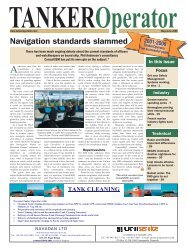Features: Features: - Tanker Operator
Features: Features: - Tanker Operator
Features: Features: - Tanker Operator
Create successful ePaper yourself
Turn your PDF publications into a flip-book with our unique Google optimized e-Paper software.
INDUSTRY - NEWS<br />
IMO agrees vessels’ air pollution regulation amendments<br />
Draft amendments to<br />
revise MARPOL<br />
regulations on the<br />
prevention of vessel air<br />
pollution were agreed at<br />
the recent meeting of<br />
the IMO sub-committee<br />
on bulk liquids and<br />
gases (BLG).<br />
The sub-committee agreed a draft<br />
revised Annex VI to the<br />
MARPOL Convention and<br />
amendments to the NOx<br />
Technical Code. These will now<br />
be submitted to the marine<br />
environment protection<br />
committee (MEPC), which meets<br />
for its 57th session from 31st<br />
March to 4th April this year.<br />
A number of options remain<br />
open for discussion at MEPC,<br />
which is expected to approve the<br />
amendments prior to their formal<br />
adoption at MEPC 58 (6-10th<br />
October). The amendments would<br />
then enter into force 16 months<br />
later, in March 2010, or on a date<br />
to be decided by the committee.<br />
The comprehensive report by<br />
the informal cross government/<br />
industry scientific group of<br />
experts, established to evaluate the<br />
effects of the different fuel options<br />
proposed under the revision of<br />
MARPOL Annex VI, together<br />
with the outcome of the intersessional<br />
meeting of the air<br />
pollution working group held in<br />
Berlin in October/November 2007,<br />
enabled the BLG sub-committee<br />
to make significant progress.<br />
The working group was tasked<br />
with reviewing six options. The<br />
sub-committee agreed to reduce<br />
the six options to just three, as<br />
listed below (The figures in square<br />
brackets remain open for further<br />
consideration by the MEPC):<br />
Option 1 Global<br />
1% (10,000 ppm)* fuel<br />
standard applied globally in<br />
[2012]<br />
0.50% (5,000 ppm) fuel<br />
standard applied globally in<br />
[2015]<br />
Option 2 Global / regional<br />
Global cap remains unchanged<br />
at 4.50% (45,000 ppm)<br />
Emission Control Areas require<br />
0.10% (1,000 ppm) standard in<br />
[2012]<br />
Option 3 Global / regional with<br />
micro-areas<br />
Global cap is lowered to 3%<br />
(30,000 ppm) in [2012]<br />
Emission control area standard<br />
lowered to 1% (10,000 ppm) in<br />
[2010]<br />
Emission control area standard<br />
lowered to 0.50% (5,000 ppm)<br />
in [2015]<br />
Micro-emission control areas may<br />
be established at a distance of no<br />
more than 24 miles from the<br />
baseline with a 0.10% (1,000<br />
ppm) standard. A proposal for the<br />
control areas must be submitted to<br />
the IMO for review, but are to be<br />
subject to a relaxed set of criteria.<br />
These three options have now<br />
been put to the MEPC. However,<br />
the respective implementation<br />
dates, control levels, and concepts<br />
outlined in the above options<br />
would all be subject to debate and<br />
modification.<br />
Concern<br />
A concern was raised over<br />
whether sufficient quantities of<br />
compliant fuel would be available<br />
to support the options. All the<br />
options would require significant<br />
changes in product output from<br />
many refineries around the world,<br />
with some representing an<br />
unprecedented single step<br />
regulatory change compared to<br />
those that have driven global fuel<br />
markets in the past decade.<br />
Particular attention was drawn to<br />
the need to maintain the production<br />
link between marine fuel and landbased<br />
fuel with respect to<br />
specifications around the world and<br />
to adopt a phased approach<br />
enabling refinery and supply<br />
configurations to be adapted, in<br />
response to market signals, to<br />
ensure continued availability and<br />
supply without major disruption.<br />
A number of other matters<br />
were also addressed, including<br />
finalisation of draft exhaust gas<br />
cleaning guidelines and wash<br />
water discharge criteria for such<br />
systems, to be forwarded to<br />
MEPC for discussion and<br />
possible adoption by the<br />
committee. It was, however,<br />
decided not to recommend that a<br />
market-based instrument, or its<br />
trials, be included in the<br />
amendments to Annex VI.<br />
NOx regs for new<br />
engines<br />
The sub-committee also developed<br />
a three-tier structure for new<br />
engines, which would set<br />
progressively tighter nitrogen oxide<br />
(NOx) emission standards for new<br />
engines depending on the date of<br />
their installation. Tier I represented<br />
the 17 g/kW standard stipulated in<br />
the existing Annex VI.<br />
For Tier II, it was agreed to<br />
recommend a standard that would<br />
see NOx emission levels for<br />
engines installed from 1st January<br />
2011 reduced by a figure of<br />
between 15.5% and 21.8%,<br />
depending on their operating<br />
parameters.<br />
With regard to Tier III, a<br />
number of delegations said that a<br />
geographically based approach<br />
requiring significant reductions in<br />
designated emission control areas<br />
(ECAs), should be introduced. It<br />
was felt that such an approach<br />
would provide a global framework<br />
for reducing NOx emissions in<br />
coastal areas with the most severe<br />
problems, while allowing<br />
operation at the Tier II level<br />
outside the designated ECAs. This<br />
approach would offer significant<br />
protection of the environment and<br />
human health, while avoiding the<br />
increased fuel consumption that is<br />
associated with less advanced<br />
NOx reduction technologies, the<br />
committee said.<br />
The recommended Tier III<br />
standard, applicable to newbuilds<br />
beginning on 1st January 2016,<br />
will, therefore, see a reduction of<br />
80% from Tier I levels in specific<br />
ECAs designated through IMO.<br />
The organisation will develop<br />
area designation guidelines,<br />
taking into account the<br />
environmental impact. The<br />
meeting also noted that Japanese<br />
engine manufacturers were<br />
already developing advanced<br />
engine treatment systems to meet<br />
the proposed Tier III standard.<br />
As for existing engines, the<br />
working group also looked at<br />
whether it was possible to establish<br />
a standard applicable to pre-2000<br />
marine diesel engine installations.<br />
While a wide range of opinion<br />
exists on the question of whether<br />
such a standard is appropriate and<br />
practical, many delegations felt<br />
that insufficient information and<br />
studies had been submitted to<br />
make a decision. It was, therefore,<br />
agreed that further information<br />
would be necessary at MEPC 57.<br />
NOx Technical Code<br />
As for the NOx Technical Code,<br />
earlier debates concerning the<br />
certification of serially produced<br />
engines, direct measurement and<br />
monitoring methods, a draft<br />
certification procedure for<br />
existing engines, and test cycles<br />
to be applied to Tier II and Tier<br />
III engines, were resolved.<br />
It was agreed that this should<br />
be left to the administration to<br />
decide whether serially produced<br />
engines will be required to be<br />
certified individually, and that<br />
each engine should be<br />
accompanied throughout its life<br />
on board ship, while under the<br />
authority of an administration, by<br />
a certificate demonstrating its<br />
conformity as part of a generic<br />
engine family certification, or a<br />
certificate issued for a single unit.<br />
Draft text for chapter 6.4 of the<br />
NOx Technical Code concerning<br />
direct measurement and<br />
monitoring was further developed<br />
and agreed, and test cycles to be<br />
applied for the Tier II and Tier III<br />
NOx standards were also agreed.<br />
It was, however, recognised that<br />
the test cycle and respective load<br />
points may be reviewed in the<br />
TO<br />
future, as necessary.<br />
* The respective parts per<br />
million (ppm) and corresponding<br />
percentages all refer to<br />
maximum sulphur content limits.<br />
06<br />
TANKER<strong>Operator</strong> March 2008

















